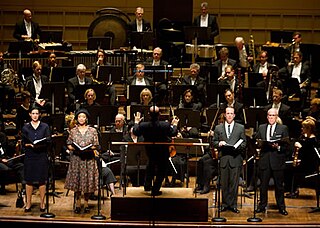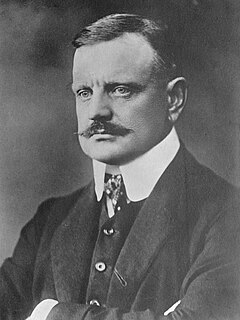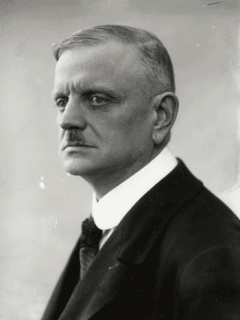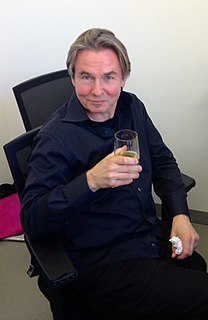
Esa-Pekka Salonen is a Finnish orchestral conductor and composer. He is principal conductor and artistic advisor of the Philharmonia Orchestra in London, conductor laureate of the Los Angeles Philharmonic, and music director-designate of the San Francisco Symphony.
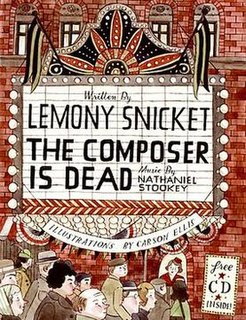
The Composer Is Dead is a composition for narrator and orchestra, released both as a musical recording and as a book with a CD insert, with text by Lemony Snicket, music by Nathaniel Stookey, and illustrations by Carson Ellis. It is a whodunnit about the orchestra.
Naïve and Sentimental Music is a symphonic work by the American composer John Adams. The title of the work alludes to an essay by Friedrich Schiller, On Naïve and Sentimental Poetry, that contrasts a creative personality that creates art for its own sake versus one conscious of other purposes, such as art’s place in history. The composer cites both the slowly developing harmonies of Bruckner's Fourth Symphony and the atmosphere of the Sonoma coastline as inspirations for the work. The piece was co-commissioned by the Los Angeles Philharmonic, the Ensemble Modern, the Vancouver Symphony Orchestra, and the Sydney Symphony Orchestra. It received its first public performance by the Los Angeles Philharmonic conducted by Esa-Pekka Salonen on February 19, 1999. A recording by Salonen and the Los Angeles Philharmonic was subsequently released by Nonesuch Records.
My Father Knew Charles Ives is an orchestral triptych by the American composer John Adams. The work was commissioned by the San Francisco Symphony. It was first performed by the San Francisco Symphony under the direction of Michael Tilson Thomas at the Louise M. Davies Symphony Hall on April 30, 2003.
The Symphony by the American composer Steven Stucky is a four-movement symphony for orchestra. The work was jointly commissioned by the New York Philharmonic and the Los Angeles Philharmonic. It was composed from January through July 2012 and premiered September 28, 2012 at the Walt Disney Concert Hall in Los Angeles, with conductor Gustavo Dudamel leading the Los Angeles Philharmonic. The work had its New York City premiere November 29, 2012, with Alan Gilbert leading the New York Philharmonic.
The Second Concerto for Orchestra is a concerto for orchestra by the American composer Steven Stucky. The work was commissioned by the Los Angeles Philharmonic while Stucky was their composer-in-residence for the inaugural season of the Walt Disney Concert Hall. It was completed in 2003 and was first performed on March 12, 2004, with the conductor Esa-Pekka Salonen leading the Los Angeles Philharmonic. The piece was awarded the 2005 Pulitzer Prize for Music.
Jeu de timbres is a single-movement orchestral composition by the American composer Steven Stucky. The work was commissioned by the National Symphony Orchestra and completed in late 2003. It was premiered in January 2004, with the National Symphony Orchestra performing under conductor Leonard Slatkin.
Son et lumière is a symphonic poem by the American composer Steven Stucky. It was commissioned by the Baltimore Symphony Orchestra and composed between June and December 1988. The work was premiered in Baltimore by the Baltimore Symphony Orchestra under conductor David Zinman, May 18, 1989.
The B-Sides is a symphony in five movements for electronica and orchestra by the American composer Mason Bates. The work was commissioned by the San Francisco Symphony and conductor Michael Tilson Thomas, with support from the Ralph I. Dorfman Commissioning Fund. It was premiered May 20, 2009 at the Louise M. Davies Symphony Hall in San Francisco, with Michael Tilson Thomas leading the San Francisco Symphony.
Pinturas de Tamayo is an orchestral composition in five movements by the American composer Steven Stucky. The work was commissioned by the Chicago Symphony Orchestra, who premiered the work on March 28, 1996, under the conductor Michael Gielen in Symphony Center, Chicago. The piece is inspired by the paintings of the Mexican artist Rufino Tamayo.
Nyx is a symphonic poem by the Finnish composer Esa-Pekka Salonen. The work was jointly commissioned by Radio France, the Barbican Centre, the Atlanta Symphony Orchestra, Carnegie Hall, and the Finnish Broadcasting Company. It was premiered February 19, 2011 in the Théâtre du Châtelet, Paris, with Salonen conducting the Orchestre Philharmonique de Radio France. The piece is titled after the Goddess Nyx from Greek mythology.
Fanfare Ritmico is a single-movement orchestral composition by the American composer Jennifer Higdon. The work was commissioned by The Women's Philharmonic as part of The Fanfares Project. It was given its world premiere in March 2000 by conductor Apo Hsu and the Women's Philharmonic.
The Stars and the Roses is a three-movement composition for tenor solo and orchestra set to the poetry of Czesław Miłosz by the American composer Steven Stucky. The work was commissioned by the Berkeley Symphony, for which Stucky was then composer-in-residence. It was first performed on March 28, 2013 by the tenor Noah Stewart and the Berkeley Symphony under the conductor Joana Carneiro. The work was rewritten by Stucky in a chamber arrangement of the piece that premiered on October 18, 2013 by the Curtis 20/21 Contemporary Music Ensemble and tenor Roy Hage. The piece is dedicated to Stucky's wife Kristen.
The Symphony is an orchestral composition in four movements by the American composer Christopher Theofanidis. It was commissioned by the Atlanta Symphony Orchestra, which premiered the work under the conductor Robert Spano in April 2009. The piece is dedicated to Robert Spano "in admiration and friendship."
Polaris: Voyage for Orchestra is an orchestral composition by the British composer Thomas Adès. The work was co-commissioned by the New World Symphony under the direction of Michael Tilson Thomas for the opening of the New World Center. The New World Symphony was joined in commission by the Royal Concertgebouw Orchestra, the New York Philharmonic, the Calouste Gulbenkian Foundation, the Barbican Centre, the Los Angeles Philharmonic, and the San Francisco Symphony. It was given its world premiere by Michael Tilson Thomas and the New World Symphony at the New World Center in Miami Beach on January 26, 2011.
Laterna Magica is an orchestral composition by the Finnish composer Kaija Saariaho. The work was commissioned by the Berlin Philharmonic and the Lucerne Festival. Its world premiere was given by the Berlin Philharmonic under the direction of Simon Rattle at the Berliner Philharmonie on August 28, 2009.
Dreamwaltzes is an orchestral composition by the American composer Steven Stucky. The work was commissioned by the Minnesota Orchestra for their annual Sommerfest series with support from the Jerome Foundation. The piece was completed in April 1986 and its world premiere was given by the Minnesota Orchestra under the direction of Leonard Slatkin on July 17, 1986. It is dedicated to the violinist Sonya Monosoff and Carl Pancaldo. The piece brought Stucky to prominence in the contemporary classical community and remains one of his most popular compositions.
Sculpture is an orchestral composition by the Finnish composer Magnus Lindberg. The music was commissioned by the Los Angeles Philharmonic with support from the Koussevitzky Music Foundation to celebrate the orchestra's inaugural season at the Walt Disney Concert Hall. Its world premiere was given by the Los Angeles Philharmonic under the direction of Esa-Pekka Salonen on October 6, 2005.
Auditorium is a 2016 composition for electronica and orchestra by the American composer Mason Bates. The work was commissioned by the San Francisco Symphony with support from Larry and Michèle Corash. Its world premiere was given by the San Francisco Symphony conducted by Pablo Heras-Casado on April 27, 2016. The piece is dedicated to Larry and Michèle Corash.

